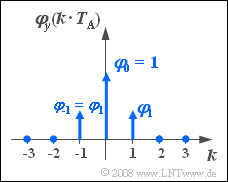Exercise 5.6Z: Filter Dimensioning again
Using a first-order non-recursive digital filter, generate a discrete-time random sequence $\left\langle \hspace{0.05cm} {y_\nu } \hspace{0.05cm} \right\rangle$ that has the following ACF values:
- $$\varphi _y ( {k \cdot T_{\rm A} } ) = \left\{ {\begin{array}{*{20}c} {\varphi _0 = 1} & {\rm for} & {k = 0} \\ {\varphi _1 } & {\rm for} & {\left| k \right| = 1} \\ 0 & {} & {{\rm{otherwise}}.} \\ \end{array}} \right.$$
Here $\varphi_1$ denotes a parameter that can be freely chosen (within certain limits).
Further, it holds:
- The discrete-time input values $x_\nu$ are Gaussian distributed with mean $m_x$ and standard deviation $\sigma_x$.
- For the whole exercise $\sigma_x= 1$ is valid. The mean value is initially $m_x = 0$.
- In the subtask (4) $m_x = 1$ is valid.
Thus the system of equations for the determination of the filter coefficients $a_0$ and $a_1$ is:
- $$a_0 ^2 + a_1 ^2 = 1, $$
- $$a_0 \cdot a_1 = \varphi_1 .$$
Notes:
- The exercise belongs to the chapter Creation of Predefined ACF Properties.
- Reference is also made to the chapter Auto-Correlation Function.
Questions
Solution
- $$a_0 \cdot a_1 = \varphi_1 \hspace{0.3cm}\Rightarrow\hspace{0.3cm} a_1 = \varphi_1 /a_0 ,$$
- $$a_0^2 + a_1^2 = 1 \hspace{0.3cm}\Rightarrow\hspace{0.3cm} a_0^2 + \varphi_1^2 /a_0^2 -1 = 0,$$
- $$u = a_0^2 \hspace{0.3cm}\Rightarrow\hspace{0.3cm} u + \varphi_1^2 /u -1 = 0 \hspace{0.3cm}\Rightarrow\hspace{0.3cm} u^2 - u + \varphi_1^2 = 0.$$
- This leads to the two solutions:
- $$u_{1/2} = 0.5 \pm \sqrt {0.25 - \varphi _1 ^2 } .$$
- Real solutions exist only for $\varphi_1^2 \le 0.25$, which means:
- $$\hspace{0.15cm}\underline {\varphi_\text{1, max} = +0.5}, \quad \hspace{0.15cm}\underline {\varphi_\text{1, min} = - 0.5}.$$
(2) With $\varphi_1=-0.3$, we get $u_1 = 0.9$ and $u_2 = 0.1$ resulting in the following sets of parameters:
- $$\text{Solution 1:} \ \ a_0 = \;\;\,\sqrt {0.9} = \;\;\, 0.949,\quad a_1 = - \sqrt {0.1} = - 0.316;$$
- $$\text{Solution 2:} \ \ a_0 = - \sqrt {0.9} = - 0.949,\quad a_1 = \;\;\, \sqrt {0.1} = \;\;\, 0.316;$$
- $$\text{Solution 3:} \ \ a_0 = \;\;\, \sqrt {0.1} = \;\;\, 0.316,\quad a_1 = - \sqrt {0.9} = - 0.949;$$
- $$\text{Solution 4:} \ \ a_0 = - \sqrt {0.1} = - 0.316,\quad a_1 = \;\;\, \sqrt {0.9} = \;\;\, 0.949.$$
- Only the first parameter set satisfies the specified constraint:
- $$a_0 \hspace{0.15cm}\underline {= 0.949} \ \text{ und } \ a_1 \hspace{0.15cm}\underline {= -0.316}.$$
(3) If $\sigma_x$ is doubled, all ACF values increase by a factor of $4$. In particular, then holds:
- $$\varphi _y( {T_{\rm A} } ) = - 0.3 \cdot 4 \hspace{0.15cm}\underline{= - 1.2}.$$
(4) The DC component $m_x = 1$ at the input leads to the following DC component in the output signal:
- $$m_y = m_x \cdot ( {a_0 + a_1 } ) = 1 \cdot (0.949 -0.316) = 0.633.$$
- All ACF values are therefore increased by $m_y^2 \approx 0.4$ compared to subtask (3) and we now obtain:
- $$\varphi _y( {T_{\rm A} } )\hspace{0.15cm}\underline{ \approx - 0.8}.$$
